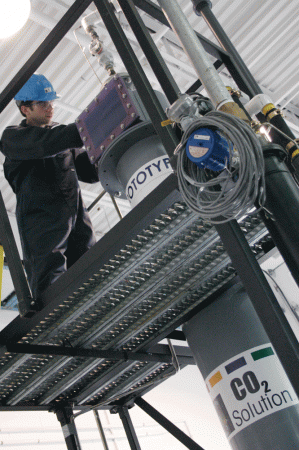
What to do with CO2?
By PLANT STAFF REPORT
Industry Sustainability Energy Manufacturing Resource SectorA pilot with Husky Energy and a program run by EERC will put the enzyme-enabled carbon capture technology to the test.
Oil sands and heavy oil extractors are under a lot of pressure from governments, environmentalists, citizens and celebrities to do something about escalating greenhouse gas emissions as their energy plays are developed.
A key concern is what to do about all that carbon dioxide (CO2) generated by extraction operations. One potential solution is the development of carbon capture and sequestration (CCS), or carbon capture and storage, but it’s an expensive proposition so far and there are concerns that stowed CO2 will escape some day and create a lot of environmental havoc.
CO2 Solutions, a developer of an innovative enzyme-enabled carbon capture technology based in Quebec City, believes it has a lower cost and greener solution that adds a U for utilization to the CCS acronym.
Its patented technology, using the enzyme carbonic anhydrase – naturally found in living organisms to manage CO2 during respiration – is aimed at stationary emissions sources such as oil production, power and steam plants and metals production facilities, and leverages existing solvent-based gas scrubbing processes.
A salt solvent and the enzyme scrubs collected flue gas and absorbs the CO2 on the left side of the process. The CO2-absorbed solvent is then sent to the right side where regeneration occurs, freeing the solvent of the CO2 and recovering a pure stream of the gas. The CO2 is compressed, stored and used for other applications rather than being pumped it into the ground and sequestered. Some of these uses include helping greenhouse plants grow faster, PH regulation in the pulp and paper industry, and for carbonation at bottling plants. But it is also a promising solution for oil and gas companies.
Billions of barrels of harder to recover heavy oil reserves can be extracted pumping captured CO2 into aging wells.
CO2 Solutions has been busy testing and piloting its technology and has made a couple of important announcements. It’s going to run a pilot at Husky Energy’s Pikes Peak South heavy oil site in Saskatchewan, and CO2 Solutions says the project will be sized to capture up to 10 tonnes of CO2 per day.The federal ecoEnergy Innovation Initiative is providing $5.2 million for the project. Another $500,000 came from the Climate Change Initiative Management Corp., Alberta’s climate change investment arm.
Procurement has started and construction is to be completed early next year with commissioning in the first quarter. Operation will conclude in the third quarter, for a run time of 2,500 hours.
Initial lab testing at CO2 Solutions’ 96,000 square-foot R&D facility proved that its process operated at a 0.5 ton per day scale, which significantly reduces the cost of CO2 capture below current technology.
The company also signed an agreement with the University of North Dakota’s Energy & Environmental Research Center (EERC) to join its carbon capture program as a sponsor.
Under the Advancing CO2 Capture Technology: Partnership for CO2 Capture Phase III program, CO2 Solutions will test its technology in December at EERC’s facility using natural gas and coal flue gas.
Benchmarking performance
The program is evaluating several carbon capture technologies that are among the most advanced systems under development, for use at power and steam generation plants.
CO2 Solutions says data collected from the EERC tests, which will have approximately twice the capacity of its largest testing to date, will provide valuable input for the Husky Energy pilot, plus performance benchmarking of its enzyme-accelerated process against other solvent-based processes.
“We expect the program will benefit our US market entry, particularly for commercial applications such as enhanced oil recovery, through the exposure of our technology to the program’s prominent industry participants,” says Evan Price, president at CEO of CO2 Solutions.
He says the EERC program also offers a flexible platform that allows for the testing of different equipment configurations.
The US Department of Energy provides part of the program’s funding.
CO2 Solutions is realigning its testing program as it prepares for commercial opportunities in North America.
It has ended its association with Neumann Systems Group, a designer and builder of emissions control systems for power plants and other industrial applications that’s based in Colorado Springs, Co., saying in a press release that the collaboration is “no longer in its best interests.”
The companies announced in July they were accelerating preparations for a pilot facility in Colorado Springs that would capture approximately 10 tonnes of CO2 per day. Start-up was originally set for April 2015, but it was moved ahead to October.
“We are now focusing our attention and resources on alternative collaborations to meet our objective of offering a low-cost, next-generation commercial CO2 capture system for applications such as enhanced oil recovery,” says Price.
Thom Skinner, CFO of CO2 Solutions, says the two companies are parting amicably, noting one such alternative collaboration is the EERC program.
“The EERC is a primary testing ground for CO2 capture in the US. This provides significant credibility and an introduction to a [variety] of prominent players in the CO2 capture and reuse market. North Dakota is also a prime market for CO2 applied to enhanced oil recovery (EOR). We have limited resources and we have to pick our spots carefully,” says Skinner. “The opportunity to test at EERC was one we didn’t want to pass up.”
If the tests and pilots prove CO2 Solutions’ process is a winner, perhaps it will have the added effect of reducing the amount of CO2 exhaled by the fossil fuel extraction critics, or at least give them something to talk about.
This article includes files provided by Noelle Stapinksy from the report in the September/October issue of PLANT West (CO2’s GHG solution).
This article appears in the October 2014 issue of PLANT.
Print this page
Advertisement
<


